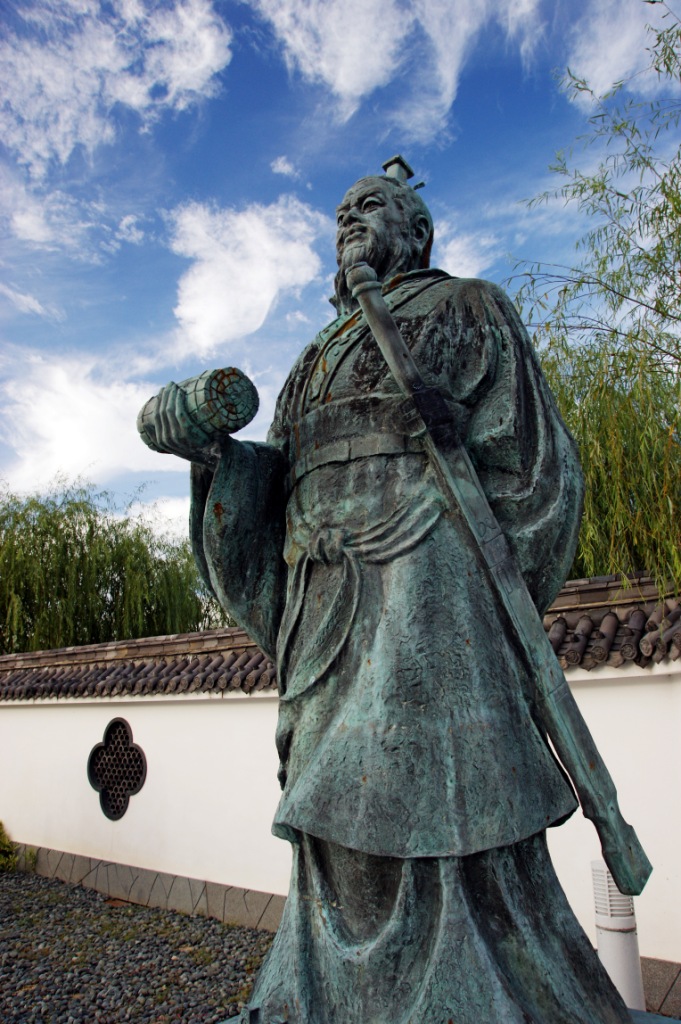Ambitious people worldwide from business folk to army generals make use of The Art of War, an ancient Chinese book written more than two millennia ago. Who was author Sun Tzu? Emily Zhou looks at the man behind the myth.
IT WAS ONE OF the most turbulent periods in Chinese history. Nearly every day, people lost their lives because of the endless slaughter during the time known as the “Spring and Autumn Period”, more than 25 centuries ago. China was split into various states which struggled against each other for power.
In 544 BC, a boy was born into a military family. The family’s name was Sun (孫) and they lived in Qi State (齊國). His grandfather was a military man, a general who had the Chinese characters “止” and “戈”, in his name – terms meaning “laying down” and “weapon”.
The boy was called Sun Wu (the name he is famous for today, Sun Tzu, means “Master Sun”).

While still in his teens, Sun Wu was educated and strongly influenced by his uncle Tian Rangju (田穰苴), a government minister and a man acclaimed for his military skill.
The boy saw captives from other countries sent back in exchange for his countrymen’s own soldiers captured by other states. He realized that the most effective method of dealing with the conflicts between countries was diplomacy, rather than war.
However, if physical conflict was inevitable, it had to be confronted in wise ways, and the ultimate purpose of fighting was to cease wars.
“There will be danger if war preparations are neglected,” (忘戰必危), said Sun Wu’s father. That point took root in the young man’s thinking and stayed with him.
To keep the peace, you needed to know how to fight, and start preparations long before any actual battle.
A RECLUSE IN THE MOUNTAINS
In 530 BC, 14-year-old Sun Wu followed his uncle’s advice and left for Wu State (吳國) because of serious fighting among Qi aristocrats. As soon as he arrived in Wu, he began a reclusive period in the mountains, which was a very helpful time for him to summarize in his mind the military strategies originated by his uncle, and add new ideas of his own.
During this period, Sun Wu became acquainted with a man named Wu Zixu (伍子胥), who was deeply attracted by the young man’s outstanding military thinking.
“Your strategies will be surely appreciated by the King of Wu,” Wu Zixu said.
“I never thought of serving a ruler,” said Sun Wu. “My only dream is to pass my uncle’s wisdom down for later generations.”

However, Wu Zixu was an ambitious man. He was committed to becoming a powerful government minister one day, and he eventually achieved that. He assisted a prince named Guang (公子光) to come to the throne and become the most successful ruler in the history of Wu State.
But Wu Zixu never forgot the young man whom he had met in seclusion in the remote mountains. It is said that he recommended Sun Wu seven times a day to the King!
And of course, Sun Wu was called into the palace one day.
SUN BECOMES STRATEGIST FOR THE KING
The King was very pleased to listen to Sun Wu sharing his military strategies. At that time, the state of Wu was suffering from frequent attacks from the state of Chu (楚國). This was a powerful and affluent state located in what is now Hubei Province (湖北省).
Wars begin long before the actual fighting, by the making of detailed preparations, Sun said.
Under his advice to “accumulate the grain and set up fortresses”, the King decided to make all-round preparations for the coming wars against Chu.
After the actual fighting began, it became clear that the grain supply provided strong support for the soldiers and the people of Wu, and the advanced preparations of fortresses and weapons enhanced the army’s fighting abilities.
SIX YEARS OF WAR
For the next six years, the Wu State, under the advice of Sun Wu, launched a series of attacks against the Chu, which became increasingly weary of fighting. The originally powerful State of Chu gradually became the weaker side.
In 506 BC, Wu allied with several smaller states that were rivals of Chu and led troops against Chu’s army, eventually winning. This fight, called “the Battle of Boju” (柏舉之戰), became a milestone in the history of ancient Chinese warfare. After that, nearly 100 years of warfare between Wu and Chu largely subsided to peace.
SUN BECOMES DISILLUSIONED
However, after winning the battle, the King of Wu did not heed Sun Wu’s advice to work on re-organising his army and letting his people rest and recuperate, but remained in Chu to enjoy himself.
Soon, Wu’s neighbour, Yue State (越國), seized the opportunity to attack the land of Wu. The king’s brother took advantage of the chaos to seize power and claim the throne, and Qin (秦國) sent troops to help Chu. This left Wu in crisis.
Sun Wu became disillusioned and retreated back to the mountains.
Ten years later, the King of Wu was badly wounded in a war with Yue and summoned Sun Wu for urgent reinstatement. But the military strategist refused.
In 473 BC, the state of Yue annihilated the state of Wu. This land, once a marvel of warfare, disappeared from history like a shooting star which glows brightly but quickly fades to nothing.

Meanwhile, a book was created which captured the military strategies of Sun, probably combined those of other leaders around the time it was written. It became the most popular such book in history, and is still in bookshops today, having been translated into all the main languages of the planet.
The opening sentence tells readers to take conflict seriously. “War is a grave affair of the state; it is a place of life and death, a road to survival and extinction, a matter to be pondered carefully.” (兵者,国之大事,死生之地,存亡之道,不可不察也.)
Image at the top is artwork by Fridayeveryday
